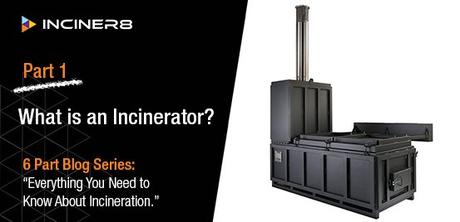
Incineration is a heat treatment process which involves the combustion of organic substances contained within the waste materials. The process of incineration requires high temperatures which are used to initiate the process, which supports the thermal treatment process to enable any material waste to be broken down into its chemical component through oxidisation.
The incineration process is the oxidisation of materials contained in all waste types. Waste overall is made up of many differing component parts, consisting of organic, minerals, metals, and water.

Incineration of materials reduces the original waste into their main comment parts i.e. fly ash, flue gases and heat. There are systems which can be integrated into incinerators to use the heat for either space heating, generation of electricity or a combination of both. This is known as Waste to Energy (W2E) or Energy from Waste (EfW).
There is an increasing demand to use waste as a fuel and energy source . The advantage of these systems is that it reduces waste going into land fill and river or sea. However, the challenge is ensuring that the emission from the incineration process are strictly controlled, to ensure that air controlled and compliant with operating regulations and legislation.
 Waste to Energy (W2E) Process
Waste to Energy (W2E) Process Large scale modern incinerators are well established, and examples can be seen all over Europe and the wider world. However, there is a growing need to develop incinerators which are small scale and specifically developed for localised disposal for a range of waste streams.
There is also a requirement for not just incinerating waste but also to capture the energy and use it for other uses i.e. the generation of electricity, space heating or combination of both.
Understanding Waste
It is crucial to understand what is waste in the context of incineration and disposal. Waste is generally defined as;
... any substance or object which the holder discards or intends or is required to discard...
2008 Waste Framework Directive (Directive 2008/98/EC)
Essentially materials or products which have come to the end of their useful life and are disposed as no value items.
The principles of consumers consumption and the culture of single use materials is prevalent within the global economy and hence the need for disposal of these items in a manner which reduces pollution of the land, sea and air.
Where does waste come from?
Waste is generated from all elements of society and industry which ranges from common household waste to specialist waste from medical, farming and many other industries.
The waste process starts with human activity in the commercial and domestic sectors. The waste generated is usually collected and sent to a transfer station. The transfer station then sorts the mixed waste into some elements of component parts (metals, plastics etc), which are sent for recycling, incineration, and landfill.
Is Incineration the Right Disposal Method for My Waste?
Whether your waste is suitable for incineration comes down to the composition of your waste and how it has been sorted.
For example, the more moisture present in the waste the less efficient the burn cycle will become. This is due to the heat energy being used up to dry the waste before it ignites. Similarly if the waste is densely compacted and there is little room for air, the incineration process will slow again - this time due to a lack of oxygen.
It is also important to consider if your waste is safe to incinerate and whether it is the most efficient solution of disposal. Inciner8 will always recommend recycling materials where possible.
This blog is of a 6 part series on "Everything You Need to Know About Incineration", brought to you by our expert technical team at INCINER8

